where do I start?
Hi
I am in Central Florida where summer is hot and wet and the soil very sandy. II would like to go organic but after reading a few post, I am quite lost as to how get started. Wha should I do first?
Thanks
Comments (57)
strawchicago z5
9 years agolast modified: 9 years agoHi Sharon: Glow-in-the-Dark jewelry would be a big hit for kids ... I have an 11 year-old daughter, and kids love such stuff. Tomato-tone is better than Rose-tone, since it's higher in potassium. Austin roses require higher potassium for best water-uptake with its many petals.
I boil my chopped-up red-cabbage in a metallic pot, then I pour warm juice over soil samples in those plastic fruit-cup (pre-labeled). Wait at least 20 min to allow soil elements to interact. When I first tested the rose park soil sample ... it was still pinkish. Then after 30 min., it was almost as blue as my soil pH of 7.7 (tested by EarthCo.). .
When I tested coffee ground, it was pinkish. But after 30 min., it became clear. Coffee ground is a buffer: it neutralizes the soil.
I notice that the plants next to my patio give the best blooms The patio's base is lime stones. Lime stone is rich in nutrients, high in calcium, plus trace elements.
According to Texas A & M research, application of soluble calcium increase absorption of ammonium up to 100%, and increase intake of potassium and phosphorus. That's the logic for Roses Unlimited's recommendation of 1 cup of gypsum (calcium sulfate) in the planting hole. However, gypsum has 17% sulfur (makes it more acidic), so pelletized lime is a better choice for acidic soil.
In acidic soil, aluminum is toxic to roots, versus calcium chloride and calcium sulfate (gypsum) help root growth.
Aluminum decreases both root growth and nitrate uptake.
See link: http://link.springer.com/article/10.1007/BF00011325
Pine bark (pH 4.5) is high in aluminum, which explains for poor winter survival rate when I mulched roses with that in my last house. Ash-pellets would be too caustic to mix in the hole, best kept on top, above a thick layer of leaves, and let rain work that in. Types of lime:Equivalent Calcium Carbonate pH change
Dolomitic Limestone 70-95 Slow source of magnesium
Ground limestone 70-95 Slow
Hydrated Lime 140 Fast Hazardous, difficult to apply
Pelletized Limestone 70-95 Fast Easy to apply, more expensive
Hydrated Lime is what water-treatment plants use. The calcium hydroxide in tap water is DIFFERENT, very unstable, and binds with potassium & nutrients in soil ... my roses become pale & stop blooming. That hurt plants by making concrete out of soil.
Below is Radio Times rose when it was next to my patio, fertilized itself with the lime stones beneath the patio. See link below for Texas A & M article "using soluble calcium to stimulate plant growth":
Here is a link that might be useful: Texas A & M research on soluble calcium
This post was edited by Strawberryhill on Mon, Jul 21, 14 at 14:09
strawchicago z5
9 years agolast modified: 9 years agoHi Sharon & other acidic soil folks: I re-paste the info. I researched previously on wood ash below:
Both wood ash and lime stone have nutrients and trace elements beneficial for plants. Wood ash is more caustic, much higher pH, will harm roots if in direct-contact. Limestone is inert & safer for roots, and rain-water will release its nutrients slowly.
My soil is dolomitic clay, with chunks of white, gray, and beige stones mixed in ... help with firm petals & more petals ... calcium is essential for the formation of blooms. I'm next to a lime stone quarry.
Here's an excerpt from the link below: http://hubcap.clemson.edu/~blpprt/bestwoodash.html
Table 1. Range in elemental composition of industrial wood ash samples and ground limestone.WOOD ASH ******** LIMESTONE Concentration in %
Calcium 15 *** 31
Potassium 2.6 *** 0.13
Aluminum 1.6 *** 0.25
Magnesium 1.0 *** 5.1
Iron 0.84 *** 0.29
Phosphorus 0.53 *** 0.06
Manganese 0.41 *** 0.05
Sodium 0.19 *** 0.07
Nitrogen 0.15 *** 0.01Microelements Concentration in mg/kg
Wood Ash ****** Limestone
Arsenic 6
Boron 123
Cadmium 3 ***** 0.7
Chromium 57 ***** 6.0
Copper 70 ***** 10
Lead 65 ***** 55
Mercury 1.9
Molybdenum 19
Nickel 20 **** 20
Selenium 0.9
Zinc 233 **** 113Other Chemical Properties
CaCO3 Equivalent 43% (woodash) 100% for limestonepH woodash is 10.4 versus pH of limestone is 9.9
Woodash is high in calcium, potassium, zinc, chromium, and all trace elements . Woodash also contains 123 mg/kg of Boron, vital for plant growth.
Woodash has 70 mg/kg of copper, a fungicide in Bordeux mixture. It has 233 mg/kg of zinc (compared to 113 in limestone) a fungicide fraction in Mancozeb spray. It has boron, another fungicide for dry rot. It has 65 mg of lead, compared to 55 mg of lead in limestone, also a fungicide. Finally woodash has 57 mg of chromium, another fungicide, here's a quote:
"In the past, chromium was also used in cooling towers as a rust and corrosion inhibitor and as a fungicide. "
http://corrosion-doctors.org/Elements-Toxic/Chromium.htm
Here is a link that might be useful: Composition of lime stone vs. wood ash
This post was edited by Strawberryhill on Fri, Jun 13, 14 at 22:37
Related Professionals
Windham Landscape Architects & Landscape Designers · Essex Landscape Architects & Landscape Designers · Saint Charles Landscape Architects & Landscape Designers · Taylorsville Landscape Architects & Landscape Designers · Berkeley Heights Landscape Contractors · Bethel Park Landscape Contractors · Canton Landscape Contractors · Canyon Lake Landscape Contractors · Cupertino Landscape Contractors · Damascus Landscape Contractors · Fairfield Landscape Contractors · Fort Atkinson Landscape Contractors · Fort Worth Landscape Contractors · Sun City Center Landscape Contractors · East Norriton Landscape Contractorsenchantedrose
9 years agolast modified: 9 years agoHi Strawberry, thanks again for all the info. We went to several stores today and could not find Tomato tone, I may have to mail order it as I couldn't find anything else organic with similar NPK ratios..
Thanks for clearing up the confusion on the wood ash and oak leaves, now I know what to do :) So much info. to digest.
We have a local farmer who sells aged horse manure, the soil I top dressed with has a high concentration of horse manure per my request. I'll probably get pure aged manure in the fall as his minimum order is 3 yards so quite a bit to haul around. I still haven't planted the roses yet but have been working in between raindrops to get the planting beds ready. Hopefully I can run the soil tests on Monday, it just stopped raining late today. Flowers are loving it, me, not so much.
Love your Radio Times, such a gorgeous color.
My jewelry is popular with younger woman and even some older women, hehe. It's a fun hobby/small business, brings in some extra funds to buy all my roses!! but gets a bit hectic in the fall-and crazy November thru mid December but it sure beats having a real job, that's what my husband's for ;)
Again, thanks for all your help. it has been priceless.
Sharonstrawchicago z5
9 years agolast modified: 9 years agoHi Sharon: Once you boil the red cabbage in distilled water, discard the solids, and put 1/2 to 3/4 cup of juice in a small jar. Bring that to where you order the horse manure, and scoop 1/4 to 1/3 cup manure into the jar, close it, then shake, and wait for 1 minute to see how blue it changes into ... before ordering 3 yards. If there's quick lime (very reactive) it will change the red-cabbage juice INSTANTLY to blue.
My horse manure was very alkaline, pH over 8, bluish-green in red-cabbage juice ... indicative of quick-lime (bad for plants). I get more blooms this year, because I stop using horse manure. The stable told me they use quick-lime, which is the solid form of calcium hydroxide ... NOT GOOD for plants.
Lime stones IN A NATURAL FORM, benefit plants. But Quick-lime is made by heating lime at EXTREMELY high temperature, creating an UNSTABLE, and reactive chemical, which binds with potassium & phosphorus & trace elements in soil. Not all lime are the same.
Natural elements take a long time to produce a change in red-cabbage juice (like 20 minutes with coffee ground), but with a man-made chemical like quick-lime, it changes red-cabbage juice instantly to dark blue. Light blue is OK, it's slightly alkaline, but bluish green is way-too-alkaline.
The only difference between Rose-Tone & Plant-tone, which are widely available, versus Tomato-tone is: Tomato Tone has a bit more sulfate of potash added, which you can easily buy that from Kelp4Less, $11 for 5 lbs, free shipping. Or if you want a smaller amount, it's $8 for 1 lb.
There's an agricultural study in Alabama, with acidic clay, which showed adding nitrogen-chemical fertilizer DID NOT increase crop yields, but adding sulfate of potash gave the biggest increase, next is adding phosphorus.
There's another agricultural study in soy beans which showed that using sulfate of potash and lime pellets gave HIGHEST yield, beating using fungicides & other fertilizers.
Potassium is essential for disease-prevention. I skipped putting sulfate of potash on Crown Princess Magareta ON-PURPOSE, to see what happen. It's a very disease-resistant Austin, but got a tiny-bit of Black-spot, while other roses are 100% clean.
Gruss an Teplitz is hopeless even with sulfate of potash ... I might increase the dosage on that one. I suspect that his child, Dr. Huey, has the same problem of getting potassium from the soil. My own-root Pat Austin does not have "droopy cane or neck" like the ones reported to be grafted on Dr. Huey.
Sharon, thanks for sharing about CT, where I used to live. Below are my Asiatic lilies next to limestone-based patio, I never fertilize nor water that since I planted it 14 years ago! Natural lime stones fertilize plants, but chemical quick-lime is bad for plants.
Here is a link that might be useful: Kelp4less sulfate of potash 1 lb. for $8
This post was edited by Strawberryhill on Sun, Jun 15, 14 at 11:29
enchantedrose
9 years agolast modified: 9 years agoHi Strawberry, your lilies are gorgeous...we have been hit with the orange lily beetle scourge here so lily blooms are iffy. It's so frustrating to have the buds eaten down to the stem by these vicious nasty insects.
I ordered some of the sulfate of potash from Kelp4less and should be getting it soon plus some Tomato-Tone from Amazon so I should be off to a good start. I also still need to do the soil test for ph, hoping I can get to it Weds. or Thursday then get stuff in the ground!! Hurray!enchantedrose
9 years agolast modified: 9 years agoHi Strawberry, I just bought yet more Austin Roses!!! Should I wait til fall to sprinkle the wood ash? I assume that it being so caustic it would burn the burn the leaves if applied now? Would I apply it again in early spring before the rose breaks dormancy?
Meanwhile I will be trying your cornmeal trick as preventive for black spot also the banana peels referenced in one of your other postings and can hopefully get to testing my soil ph tomorrow. I spent the whole day Tuesday with the rose vendor in NY ( a 2 1/2 hour drive each way) but it was so much fun and her roses are breathtaking. She also designed 3 garden beds for me even though several of the roses used were not purchased from her!! She is very, very knowledgeable about Austin Roses but does spray for bs and insects as well. I would consider spraying for fungus as a last resort but can't bring myself to use pesticides and endanger the lives of all the beneficial insects including honey bees and Monarch butterflies so I'll just suffer through the Japanese beetles when they come. I will be interplanting with various herbs that are said to be helpful in deterring Jap. beetles like Nepeta, Rosemary, Alliums, Chives and others so hoping that will help a little plus add some color when the roses are sleeping.
Thanks again for all your help and advice :)
Sharonstrawchicago z5
9 years agolast modified: 9 years agoHi Sharon: I look at the roses you bought, a nice selection: Zeph. Drouhin & Compassion climbers, Julia Child, The Fairy, Bolero, Munstead Wood, Lady Emma, Spirit of Freedom, Wedgewood Rose, Sceptre'd Isle, Tamora, Ambridge Rose, Lady of Shalott, Queen of Sweden.
All your choices are good except for Zeph. Drouhin, known as a disease-fest. One person in alkaline soil grew that successfully. With Zeph. Douhin, keep the surface of soil dry & alkaline, plus calcium & potassium for disease-prevention.
I grow Bolero, Scepter'd Isle, Queen of Sweden .. these are VERY clean in my alkaline clay. I'm ordering Lady Emma Hamilton (related to Pat Austin). I have Pat Austin, it's clean in my alkaline clay, but diseased for folks elsewhere. Pat is sensitive to salt in fertilizer, and acid .. and has a higher need for calcium and potassium.
Japanese Beetles are a pain here. When we first moved here 14 years ago, with no trees & no birds ... JB took over. With more trees, and more birds ... there's a drastic reduction in JB. Last year I set traps FAR AWAY from my rose gardens, caught zillions of beetles. It was fun to smash the bags with my feet, then fed dead beetles to the birds. The result? Less than 10 beetles on my 50+ roses, which I smashed between my fingers.
Fall is the best time to spread ash over the raked leaves. Winter snow & spring rain will work the ash down the acidic leaves. I WOULD NOT spread ash in early spring, unless there's tons of rain. CT has a longer spring than my Chicagoland. The spring here is short ... one year it shot up to 80 degree in March. That's why I do late-fall fertilization before the ground freeze, rather than spring.
Keep surface dry and alkaline is the key for fungal-prevention. There are many ways: Vintage band put small reddish lava rocks (for iron). Heirloom band put white perlite on top. Burlington band put dry & fresh-pine-shavings (used to line bird's cage). My neighbor mulched her roses with lime stones ... I don't recommend this, unless it's in partial shade, the stones heat up in full-sun.
For 2 years my 50+ roses were clean, thanks to the stable using recycled hard-wood (with fungicides), plus quick lime which made the horse manure pH near 8. Last year they changed: less lime, and switched to wet straw as bedding. I saw mushroom growing in the horse manure for the 1st time, didn't want to get that, but my husband wanted to finish the job.
I mulched 6 roses with that ... they broke out IMMEDIATELY in black spots and rust. I tested the pH of the new horse manure in red-cabbage juice, it's slight pink, rather than bluish green like previous years. The manure was soaking wet after the rain ... wet and neutral to slightly acidic is the ideal breeding ground for fungi.
One year I dumped tons of grass clippings in my tomato bed in the fall. They clumped together like a wet-blanket. With the melted snow & spring rain, that place became a soggy swamp. Then I planted my tomato in June 1 in the decayed & wet grass, the stems got black canker, then verticullum wilt ... worse tomato-crop in over a decade !
The next year I raked in FRESH grass clippings mid-May. Layering with the soil prevented clumping. That dried out, then planted tomato June 1 ... got a bumper-crop of tomato, and very healthy plants. I DON'T recommend piling up wet & matted leaves near roses in late fall to winterize ... already did that and created the worst BS in spring time, in my last house of acidic clay.
The best strategy would be to rake leaves AWAY from roses in the fall, then sprinkled ash-pellets on leaves. In spring, when that's dry & alkaline enough, then it's safe to mulch roses. If you get tons of rain (pH 5.6), then sprinkle more ash-pellets on top.
Keep surface dry and alkaline is the key to fungal-prevention, and pest-prevention. Rose-midge needs 25% to 75% moisture to hatch (according to Cornell University). Pests like aphids and rose slugs also need moisture to hatch.
That's why corn meal works, because it dries out the surface. pH of dry WHOLE-GRAIN corn meal is 7.5 to 7.7. My limestone clay is 7.7, no diseases as long as I don't use wet & neutral mulch. Cantigny rose park nearby, with 1,200 roses, use zero mulch, just bare dirt.
Below is Bolero floribunda, after the 1st frost late in October, it's droopy since the temp. was below 32 F. It was clean in late fall & kept all its leaves. You can see the horse-manure & wood-chips bedding (that's when it was dry & alkaline stuff).
enchantedrose
9 years agolast modified: 9 years agoThanks again Strawberry. I went rose shopping yesterday, was supposed to come home with 6 came home with 21!! Windemare, St Cecelia, Darcy Bussells, extra Lady of Shaolot, Munsteads Wood, Wedgewood Rose, Teasing Georgia, Ambridge Rose, Brother Cadfael and others!! I had 21 roses in huge pots and 2 large potted delphiniums crammed into my little Toyota Prius C. It was a long ride home but the smell was intoxicating :) Good thing I didn't get in an accident though, I would have gotten impaled! Now I need to find the time to plant them all!
Thanks for the info on the wood ash, I thought it would be best to wait til fall. I'll try your JB trick. A friend of mine is an exterminator and he told me years ago to put the traps far, far away from my house so I'll stick them in the woods down the street. I'll probably preventive spray for black spot this year as it's too late to try your methods but I'll be trying your cornmeal dusting as a preventative.
Sharonjim1961 / Central Pennsylvania / Zone 6
9 years agolast modified: 9 years agoHow much corn meal goes under and around an average size rose bush? And would it go on top of my compost? Thanks
This post was edited by jim1961 on Wed, Jun 18, 14 at 20:00
strawchicago z5
9 years agolast modified: 9 years agoHi Sharon: Congratulations to your new roses ... I would love to see their pictures. I also went overboard with heirloom tomatoes ... got 10 more than I needed.
Rose Unlimited recommends 1 cup of lime, and 1 cup of gypsum in the planting hole. It also recommends 1 cup alfalfa meal & 1 cup of superphosphate & 1 cup of red clay .... but this can be skipped, and use 1 to 2 cups of Tomato-Tone. Potassium has a mobility of 3, compared to nitrogen of 10 ... best to put high-potassium fertilizer in the planting hole, like Tomato-tone (also higher in calcium).
Austin roses with zillion petals have a higher need for calcium & potassium.
I saw pelletized lime expensive at $16 per bag, but gypsum is sold cheap at the feed store $8 for a huge bag. The feed store also sells 2 types of poultry grit: soluble vs. insoluble. The soluble is oyster shell (high in calcium, high pH). This crushed oyster-shell is also sold at pet-store as bird-feed, it doesn't get slimy like paver-lime stones. When it comes to soil-amendments, slow-released is best, that's why I prefer natural oyster shell vs. pelletized lime (raise pH too quickly). See link below:
Not sure what are the minerals in oyster shell as in SOLUBLE chicken-grit. pH of limestone is 9.9 .... my plants in yellow-limestone are VERY CHLOROTIC and pale. This link sells ground-oyster shell as plant-fertilizer:
http://www.alisorganics.com/collections/organic-fertilizer/products/oyster-shell
Here is a link that might be useful: Oyster shell garden amendment 10 lbs for $12
This post was edited by Strawberryhill on Mon, Jul 21, 14 at 14:11
jim1961 / Central Pennsylvania / Zone 6
9 years agolast modified: 9 years agoHow much corn meal goes under and around an average size rose bush? And would it go on top of my compost? Thanks
strawchicago z5
9 years agolast modified: 9 years agoHi Jim: I'll re-post corn-meal profile: NPK of corn meal is 1.6 / 0.65 / 0.4 .... that's better than horse manure NPK of 0.44 / 0.17 / 0.35.
Whole-grain-corn-meal has 23% iron, 1% calcium, only 2% sodium, plus high in B-complex vitamins. Also has 39% magnesium, 23% iron, 29% phosphorus, 10% potassium, 30% manganese, 37% selenium, 12% copper, and 15% zinc.
I already tested corn meal in the planting hole of 3 roses: Sharifa Asma, William Shakespeare, and Jude the Obscure. Very happy with the result: dark-green leaves, W.S. gave me lots of blooms. Jude has 4 buds (bought as a tiny band late fall). Sharifa Asma gave me very fragrant blooms. I put 2 cups of cracked-corn per planting hole. The feed store sells that cheap 10 pounds for $2.99. The quality of scent is amazing: I got zero scent from W.S., until this year.
The oatmeal in the planting hole was BIG disappointment, that attracted rose-slugs ... oatmeal is mushy & retains water too well. The scent is lousy on Golden Celebration.
Last summer I used 1 cup of corn-meal as fertilizer for a big bush (Frederic Mistral), and 1/2 cup for small bush (Bolero). Very high quality blooms: deep pink on Fred, and pure white on Bolero. The scent on Bolero was better than with horse-manure.
I also tested sulfate of potash on both, more blooms, but the quality is inferior: ugly grayish shade to the blooms' colors. I have seen the same with high-potassium fertilizer on marigold-blooms in University Extension experiments. The scent is much better with corn meal as fertilizer.
For the best scent, and best bloom-colors, nothing beat corn meal.
jim1961 / Central Pennsylvania / Zone 6
9 years agolast modified: 9 years agostrawchicago z5
9 years agolast modified: 9 years agoHi Jim: Your garden is so clean and neat. I'll post pics. of my tomato later. Funny that the tiny plant at $1.29 each BEAT the large size-$3.59 plant. The tiny plant catches up fast.
There are so many different types of limes .. I finally get a hang on it, after much research. The oyster shell lime has similar chemistry as egg-shell. BAD NEWS !! Those egg-shell that I threw in the compost over a year ago have NOT decomposed yet, despite the rain at pH 5.6.
Forget about what I posted earlier. Pelletized lime has been used successfully in agriculture, it's worth the $16 price. See below link from eHow. "Finely-ground lime reacts faster with the soil since it has more surface area exposed than a larger lime grind. The fine grind of the pelletized type may lead a consumer to believe it reacts faster in the soil compared to aglime (ground limestone). But the pellet's binding must disintegrate, causing the pelletized type to react slower than aglime (agricultural lime), states the University of Kentucky."
The cheap cracked corn is just as effective as the $$$ whole-grain corn-meal. If you put cracked corn under the compost, it gets wetter and break down faster, plus birds can't eat them.
Here is a link that might be useful: Differences in pelletized vs. agricultural lime
enchantedrose
9 years agolast modified: 9 years agoGood morning Strawberry- Again so much great info. to digest!! The roses are going in raised beds that have minimum 8-10 inches of compost rich soil to around 30 inches at deepest.
I'm putting in 2 narrow brick walkways in the long rectangular beds and was thinking of using the limestone gravel as a base under the bricks but I'm not sure if I can find it here, HD and Lowes don't list it on their websites. They have the red lava rocks as special order tho. so I can get some of those to experiment with. I'm hoping to get to the soil ph test today, it looks like it might rain so I'll get a rain sample to see how acidic our rain is.
What is gypsum? Is it the same as drywall? Years ago I bought some roses from breeder Mike Lowe in NH and he recommended putting in some chunks of drywall into the planting hole and a couple of non galvanized nails. I read that the nails don't add the correct kind of iron to the soil when they rust though...this could be just an old wive's tale that didn't really have any benefit although his roses in zone 4 New Hampshire were stunning. I think he did spray for pest and fungus control and warned me about JB's which he called "4th of July bugs" because they showed up without fail the beginning of July to feast on his roses.
I have some cornmeal, the expensive Quaker one, that we don't eat that I can use if this would work. I haven't had any luck finding a flour sifter though, which is very odd!! but I'll use a fine mesh strainer.
I also have some bands coming from Heirloom Roses next week, should I plant these or pot them and winter them over in their pots? We usually get a hard frost towards the end of Sept. or middle of October so I don't know if they'd have time to settle in with good root growth before then. I have ordered from HR in the past and know that their roses are tiny. I have a monster Darlow's Enigma which you can't seem to kill, that is sitting in some soil waiting for a permanent home and a Buck "Folksinger" rose that is also very healthy and big so I know that the tiny roses eventually catch up. I'm just concerned that with such a late start they might not have time to develop enough before the cold weather comes.
Thanks for the heads up on ZD rose. I had one before and don't recall it being particularly bad with bs. A vole killed it a couple years ago. It ate the roots down to a knob. This was one of my first H.R. plants that I bought probably 15 years ago so time for a new one.
Thanks again for all your help.
Sharonstrawchicago z5
9 years agolast modified: 9 years agoHi Sharon: About your own-root ZD from Heirloom: that confirm my suspicion that own-root are healthier than grafted on Dr. Huey. If you check in HMF, lots of people complain about Dr. Huey as a mildew & BS magnet.
Potassium is essential for flower-production and disease prevention ... Dr. Huey's root is less efficient in getting potassium. Austin roses at the nearby park are grafted on Dr. Huey, they are big bushes, but stingy in blooms.
Sure, my own-root W.S. 2000 looks like a mini-rose, but at least I get constant-blooming, and got a 4" bloom easily. Golden Celebration gave me the largest bloom when it was a tiny 1st year own-root.
Last year I got Jude the Obscure and Sharifa Asma from Heirloom roses in mid-July. I grew them in a pot until their root-ball became 2-gallons. I put gypsum, sulfate of potash, plus Jobes 2-7-4 tomato fertilizer (with microbes) for solid root growth. The week before Thanksgiving, I planted them 6" below soil, then mound another 6 inch. on top. They survived the coldest zone 5a winter in over a decade, with temp. below -25 degree.
Yes, gypsum is the same as plaster/drywall. "Plaster of Paris is made by heating the mineral gypsum. Large deposits were originally found outside of Paris in France hence its name. When gypsum is heated to about 150°C it losses water and produces the powder, plaster of Paris."
Gypsum is a natural mineral, so is sulfate of potash. My local Menards store sell it really expensive, like $6 for a tiny bag. The feed store sells 25 lb. for $8 .. but their gypsum has a higher % of sulfur to break up hard-clay, versus the less acidic Menards' gypsum.
If your soil is acidic, then plaster of Paris, or drywall would be a better choice. I'm impressed with Red-lava rock in supplying iron and potassium .. my perennials went crazy with blooms, in a shady garden:
I'll re-post the chemistry of RED lava rocks, it's alkaline, pH 8.2. Years ago I tried to stop the pink yarrow root from taking over my center garden. so I dug a trench, and pour bags of red lava rock, then covered it up. It backfired: the pink yarrow bloomed like mad, so did other flowers next to the red-lava rock trench.
Lava rock is used to grow bonsai, and have many nutrients such as boron, iron, zinc, copper, sulfate, plus very high in potassium. See the below link on nutrients in red lava rock:
Nitrate Nitrogen.................................4.0 p.p.m.
Phosphorus........................................6.0 p.p.m.
Potassium.........................................59.0 p.p.m.
Zinc.........................................................6 p.p.m.
Iron..................................................10.0+ p.p.m.
Copper...............................................5.5+ p.p.m.
Magnesium.......................................2.0+ p.p.m.
Boron.................................................10.0 p.p.m.
Sulfate.................................................7.0 p.p.m.
Organic Material...........................................5%
PH.........................................................8.2 Units
Calcium..................................1.3 Meq/100 gm*
Manganese...........................0.6 Meq/100 gm*
Sodium...................................0.1 Meq/100 gm*
Cation Exchange Capacity..3.2 Meq/100 gm*Here is a link that might be useful: Nutrients composition of lava rock
enchantedrose
9 years agolast modified: 9 years agoHi Strawberry, thanks. I already ordered and got the the Potassium Sulfate form Kelp4less but I'm still waiting for the tomato-tone from Amazon. I couldn't find this anywhere locally.
Thanks for the info on the Heirloom Roses plants. I'll pot these up as soon as I get them and use your recipe for growth. We don't generally ever see temps as low as yours anymore. When I was a kid we used to have -15 fairly often in the winter, now it generally never goes below zero, but it's hotter in the summer and seemingly with a lot less rain which makes you nervous with a well.
I tried the cabbage test today for ph but I think I may have gotten false readings so I'm repeating it. It indicated ph of over 8 in some of the beds. These have never been limed or fertilized but they were top dressed with a one to two inch layer of the soil/horse manure blend a couple weeks ago which tested at ph of well over 8 and we've had some rain since then so I don't know if it's leaching that quickly to 8 inches below. I'll have to contact the farmer to see if he uses lime. I retook the samples a bit deeper so I'll see if that makes a difference. Our well water has a ph of 7.8 according to our daughter's aquarium test kit so at least when I hand water I'm not adding more acid to the soil.
Sharonstrawchicago z5
9 years agolast modified: 9 years agoHi Sharon: The red-cabbage juice is accurate if one uses DISTILLED WATER, neutral pH, to boil with chopped up red cabbage. My tap water pH is over 8, measured with fish-tank litmus paper, became blue when I boiled with chopped red-cabbage.
Using red-cabbage juice boiled in Distilled Water, I tested the potting soil that came with Roses Unlimited's nursery ... it became clear, or neutral pH after 20 minutes soaking. After 2 months of watering that potting soil with my pH 8 tap-water, I tested the soil again, it was bluish, or alkaline, in red-cabbage juice.
Same with MiracleGro regular potting soil, it registered light pink in red-cabbage juice. Folks report that MiracleGro regular potting soil pH is 6.5. I also tested the MiracleGro Moisture Control potting soil, it became clear, or neutral pH in red-cabbage juice. My horse manure was bluish green, almost the same color as baking soda !!
See link below for Gracin's pictures, who used the red-cabbage procedure to show that her cow manure is VERY ALKALINE. Quick lime is often added to bagged soils and manure to deodorize, thus raising the pH.
Here is a link that might be useful: Gracin's pictures of samples in red cabbage
enchantedrose
9 years agolast modified: 9 years agoHi Strawberry, thanks again. I redid the test and got more consistent results. I think I may have gotten some of the top dressing in the mix and that's why I got the false readings. I also retested the new soil and got a lower ph so either the last sample had more horse manure in it or he does lime it and I got a sample that had a greater lime concentration. These samples look to be in the mid 6 ph range, they're not as blue as my tap water which is 7.8 but not as red purple as the lettuce sample or potato and not as green as the baking soda. I think I'll repeat this when I can find some more red cabbage, oddly not many stores in my area carry it, and make sure that I have some of the other indicators for the various ph colors. It has been eyeopening though and fun to play mad scientist!!
Thanks for the link to the pics.
Sharonjim1961 / Central Pennsylvania / Zone 6
9 years agolast modified: 9 years agolol... on fun to play mad scientist... :)
enchantedrose
9 years agolast modified: 9 years agoHi Strawberry, I just got my Kelp4Less Sulfate of Potash, Tomato Tone and cracked corn. Do you grind the cracked corn or just use it as is in the planting hole? How much sulfate of potash per rose? Some are 2 year old potted Austins some new.
Thanks for any help.
Sharonstrawchicago z5
9 years agolast modified: 9 years agoHi Enchantedrose: I love your thoughtful questions and Jim's good-natured spirit. I DON'T RECOMMEND grinding grains, except for softer sunflower seeds in a coffee grinder. I already broke 2 coffee-grinders when I grinded barley to make crunchy waffles.
I also broke my NutriMill-flour-grinder by grinding cracked corn. Crack-corn is sold $2.99 for 10 lbs. at the feed-store, its VERY ACIDIC at pH 3.5, and become even more acidic when decompose in the planting hole. OK for to break up my rock-hard alkaline clay at pH 7.7 months in advance, but not best for someone else.
I mixed cracked corn in late fall, so my zone 5a winter kill any corn-plants that sprout. In contrast, it would be a pain for someone else in a warm climate with corn sprouting all over. NPK of corn meal is 1.6 / 0.65 / 0.4 compared to horse manure NPK of 0.44 / 0.17 / 0.35.
You can see that corn has higher nitrogen, almost 4 times more phosphorus, slightly more potassium, plus B-complex vitamins, 39% magnesium, 23% iron, 29% phosphorus, 10% potassium, 30% manganese, 37% selenium, 12% copper, and 15% zinc.
Sulfate of potash NPK is 0-0-50, very high in potassium. I found out this morning that potassium LEACHES OUT of soil, and need to be re-supplied. Its mobility is a 3, somewhat mobile, compared to phosphorus mobility of 1. That's why high-phosphorus like bone meal can last for 3 years in the planting hole, but NOT so with potassium.
Phosphorus is needed in VERY SMALL amount by plants, since mycorrhyzal fungi can help plants with phosphorus-uptake. Plants need potassium much more. I posted University of Purdue field studies on alfalfa that documented the best yields were with phosphorus/potassium ratio of 1:2, also at 1:4, even on phosphorus-deficient soil.
On the bag of Muriate of Potash (high salt index of 116.2), it said to use 1 Tbs. per plant. But Sulfate of Potash has a lower salt index of 43, so it would be safe to use 2 Tbs. per plant. Consider the leaching ability of potassium, the GRANULAR sulfate of potash would be best for the planting hole, since it's a slower release.
EQUAL AMOUNT of nitrogen and potassium is documented as giving the best result in veges. seedlings per U. of Kentucky green house setting. Too much nitrogen will drive down potassium, and vice versa.
NPK of tomato tone is 3-4-6. I used 1 cup for a tiny tomato plant (6" tall), no problems whatsoever, see picture below, taken June 19. It was planted as a tiny $1.29 plant on June 2.
This post was edited by Strawberryhill on Mon, Jul 21, 14 at 14:16
strawchicago z5
9 years agolast modified: 9 years agoMy background in chemistry is a curse, since I like to experiment, rather than doing what worked best in the past. Last year I used Jobes' organic granules for tomato, NPK 2-7-4. A bumper crop, enough to give to at least a dozen neighbors & friends, plus hubby's co-workers.
But hubby noticed that tomato last year produced fruits a bit later. So this year I used Tomatoe-Tone with NPK 3-4-6, a higher ratio of nitrogen. That's for some plants, but I also used Jobes just to compare.
Since I destroyed my Gallica-rose-band with bone meal in potting soil, I used that potting soil mixed with my clay for one of my tomato. Here's the result of high phosphorus bone meal, NPK 6-9-0, in the planting hole. The Encap brand is much stronger than MiracleGro bone meal. Didn't know how much it burns, until I checked EnCap's website, and the instruction said to use 1 and 1/2 tablespoon per planting hole. I used more than that, thus the phosphorus-burnt, and plant-stunting. Luckily it's only 1 tomato out of more than dozen.
strawchicago z5
9 years agolast modified: 9 years agoBelow is the second University Extension study that documented the leaching of potassium in field crops. Both Extensions recommended frequent application of SOLUBLE POTASSIUM, due to plants' higher demand and leaching.
Slow-released potassium in the planting hole is best to prevent leaching, such as banana peels (at the bottom), so it would be decomposed once the roots reach down. I'm leaning toward Red Lava rocks mixed in with soil, since it supplies iron, boron, plus high in potassium. pH of red lava rock is 8.2, much less caustic than wood ash with pH over 11.
The $3 per bag red-lava rocks are in big chunks, but they break down fast within a year. I experimented with many in my garden, but nothing impress me as the accidental-blessing when I buried red-lava rocks to stop yallow-roots from invading my flower-bed.
Here is a link that might be useful: U. of Wisconsin Extension and potassium
strawchicago z5
9 years agolast modified: 9 years agoThis hydroponics site has an excellent chart to identify nutritional-deficiencies in plants, see link below. There's the risk of burning if fertilizer is put in the planting hole. That's why I prefer organic & balanced & low-dose and slow-released such as cracked corn and red-lava-rocks, along with Tomato-Tone NPK 3-4-6.
Bone meal at NPK 3-15-0, blood meal at NPK 12-0-0 and sulfate of potash NPK 0-0-50 would be risky in the planting hole, due to its high and concentrated amount. Sulfate of potash is best used in diluted SOLUBLE FORM, at most 1 teaspoon per gallon, so it can be distributed evenly along the root-zone.
Here is a link that might be useful: How to identify nutritional deficiency in plants
strawchicago z5
9 years agolast modified: 9 years agoBelow link shows how to identify nutritional deficiencies in existing plant, before deciding on what's best in the planting hole. Calcium and potassium are 2 nutrients most utilized by plants, and most overlooked.
Leaf-edge scorching & browning is noted by 2 sites as calcium deficiency. I'm impressed with the health & vigor of plants next to my patio (white-limestone based). I'll put some tiny white lime stones in my planting hole.
My brother in MI with acidic clay, mulched his roses with white-lime stones. His roses are grafted on Dr. Huey, with zero diseases. He also limed his 30+ acres of acidic clay, with excellent results in his field crops. His roses are in partial shade. I don't recommend that for full-sun hot climate, since the lime stones heat up.
Below is a picture of my neighbor's climbing rose, 100% clean, mulched with lime stones in partial shade. Her rose is grafted on Dr. Huey:
Here is a link that might be useful: Flow-chart to identifiy nutritional deficiency
strawchicago z5
9 years agolast modified: 9 years agoLast year I didn't use any gypsum in the planting holes of my tomato, resulting in leaf-curl, thinner leaves, and blossom-end rot. This year I put 1 cup of gypsum in the planting hole, the leaves are thick & no more leaf-curl.
Thin & leaf-curl is a sign of calcium-deficiency. Plants with calcium have firmer leaves and firmer petals. Botrytis (browning of petals) is a sign of calcium deficiency. Only my Crown Princess Magareta has that problem ... I didn't put gypsum in the planting hole.
I locate the ratio of Potassium-calcium-magnesium in a hydroponics site. The below link is priceless, it helps to identify plant nutrients-deficiency, plus what's in excess will cause deficiency. See link below: excess nitrogen, calcium, and sodium induce potassium deficiency. The recommended ratio for potassium, calcium, and magnesium is 4:2:1 ..... Potassium is needed twice more than calcium, and 4 times more than magnesium ... thus the need for frequent soluble-application.
Here is a link that might be useful: The right ratio to use in fertilizers
enchantedrose
9 years agolast modified: 9 years agoThanks again Strawberry~I started the rose planting without Alfalfa... I'll have to get some for the next few that I plant. My soil ph tested around 6 or so so I added some lime but no gypsum. Research recommended it for heavy clay soils which I don't have so I didn't know if it would be necessary as it stated it does nothing to raise soil ph. Now I'll just have to wait and see how they grow. I'm also putting in a brick pathway that will have a base of crushed marble chips which I found out are just limestone so hopefully this will leach into my soil to help keep it sweet.
Your help has been priceless and I really appreciate it.
Sharonstrawchicago z5
9 years agolast modified: 9 years agoHi Sharon: S & W greenhouse has good tips on how to plant bare-root roses. See below link. They recommended NO fertilizer whatsoever for newly planted bare-root roses .. UNTIL THEY LEAF OUT, then use MiracleGro SOLUBLE for roses bi-weekly (once every 2 weeks). I did that one year and it worked well.
I also followed S & W greenhouse approach of ONLY hummus & manure & peat moss in the planting hole .. that DID NOT WORK well for Austin roses, which have a higher need for potassium and calcium for blooming. My Austin roses were very stingy the 1st year with that approach.
Roses' Unlimited approach of: 1 cup lime, 1 cup gypsum, 1 cup alfalfa meal (NPK 2-1-2), 1 part red clay (Tomato-Tone as a substitute), 1 cup superphosphate (skip this) .. that approach yielded MORE blooms the 1st year.
S & W greenhouse has a few good points, here's an excerpt from the link below: "The use of granular types of fertilizer is NOT RECOMMENDED, as the results can be very unpredictable and the danger of burning the root system is greatly increased. Roses should not be fertilized beyond September 1st., to allow the bush to harden off for the on-coming winter months."
Here is a link that might be useful: S & W greenhouse tips on planting bare root
This post was edited by Strawberryhill on Mon, Jul 21, 14 at 14:23
enchantedrose
9 years agolast modified: 9 years agoHi Strawberry, thanks again. I have the cracked corn, pelleted lime, and tomato tone. I'll buy some gypsum and alfalfa too if I can find them locally. I know I can get alfalfa but not sure on the gypsum. I also have the miracle grow. Would you use the miracle grow with the slow release regimen (corn, alfalfa, tomato-tone) or instead of it? I don't want to overfertilize.
Also, how often do you dust the ground with cornmeal? We have had virtually no rain here for over a week so the ground is like powder. I did get black spot previously though even though we were in a severe drought so I don't think lack of rain has much of a minimizing effect on black spot.
Sharonjim1961 / Central Pennsylvania / Zone 6
9 years agolast modified: 9 years agoMan that phosphorus-burn on that tomato plant looks bad... :-/
Having a chemist background would be a curse sometimes for sure...I'd hate to see what I would do...lol
Black plants...lolI try to stay away from any type of high phosphorus fertilizers here. Our last soil test showed plenty of phosphorus in the soil.
Our roses just get top dressed with home made compost now.
I did give our tomato plants some Dr Earth "Life" Fertilizer when I planted them. Now I will not do anything to them but water for the rest of the season and hopefully I get to make some tomato sandwiches and salads later...lol
strawchicago z5
9 years agolast modified: 9 years agoHi Jim and Sharon: I dug up that "phosphorus-burn" tomato plant yesterday, rinsed in 2 buckets of water .. also replanted in FRESH soil. It perked up. Here's an excerpt from Roses Unlimited: "1 cup of 46% superphosphate & 1 cup of dolomitic lime (calcium plus magnesium) & 1 cup of Mills' Magic Rose Mix & 1 cup of gypsum & 1/4 part compost (2 gallons) & 1/4 part peat moss & 1/4 part good top soil & 1/4 part red clay or sub. with potting soil."
I disagree with superphosphate, already did that Queen of Sweden's planting hole ... when I dug that up, less root growth. Plus Q of Sweden's blooms are tiny, due to the phosphorus-overload.
If your soil is acidic clay, use just plain lime (calcium carbonate), rather than dolomitic lime (calcium & magnesium). Magnesium is what makes clay sticky .. it's rarely deficient, except in sandy soil.
The gypsum I bought cheap from the feed store has higher % of sulfur. U. of Southern CA stated that 1 lb. of gypsum is equivalent to 5 lbs. of sulfur. Gypsum has twice the salt index of lime, at 8.1 vs. around 4 for lime.
I agree with the compost, but I don't agree with the peatmoss, unless your soil is sandy and alkaline. pH of peatmoss is around 4, quite acidic. Even with my alkaline clay at pH 7.7, peatmoss glued up into concrete with my sticky clay.
Tomato-Tone is better than Mills-Magic because it's cheaper, plus more potassium and calcium. Sharon, I WOULD NOT USE MiracleGro, unless your roses are in pots, or in sandy soil. NPK of MiracleGro for roses is 18-24-16, with chelated iron, manganese, copper, and zinc. The draw back of MiracleGro is chemical nitrogen (ammonium sulfate) and urea, high salt-index. That's OK for pots or sandy soil, where it leaches out, but clay soil retains salt too well.
The instruction on MG for roses is 1 tablespoon per gallon ... I used 1/2 tablespoon per gallon and burnt Frederic Mistral in hot sun. Anything salty would stress plants in hot weather. I only use MG when I can't get a rose to bloom. Frederic Mistral finally bloom well with sulfate of potash.
The DARK-GREEN leaves roses, such as Gruss an Teplitz (parent of Dr. Huey), Romantica Sweet Promise, Double Delight, Angel Face, and Golden Celebration are black spots-prone. They are slow-growing, so I tested calcium.
I went to limestone quarry nearby, and got 150 lbs. of ground-limestone for free, the same stuff that Kelp4Less sells for $14 per 5 lb. I spread that "98% calcium carbonate" stuff on those BS-prone. After more days of rain, their leaves became THICKER plus new growth. I expected thicker leaves with calcium, but the vigorous growth was a big surprise.
The secret of growing French roses: they have a higher need for calcium, considering that "plaster of Paris" gets that name due to the gypsum deposit in France. Frederic Mistral didn't ball nor spotted when he was next to my patio (white-limestone based). When I moved him next to my house, all 70 buds got spoil with browning of petals in our recent rain.
There's a thread on Rouge Royal, a French Romantica rose, where folks complained that it doesn't bloom. Niels in Denmark, with acidic clay, posted that rose with zero blooms. But a lady in alkaline clay posted a picture of Rouge Royal with tons of blooms. I asked her how: She put gypsum in the planting hole, plus using SOLUBLE fertilizer.
Alfalfa meal doesn't have enough: only 1.25% calcium, 0.23% phosphorus, but perfect NPK ratio of 2-1-2, plus growth hormone. I already fried plants in hot summer with alfafa meal in the planting hole ... it gives off tremendous heat when decompose.
Below is Summer Samba floribunda, band-size, planted the week before Thanksgiving with 2 cups of cracked corn. It barely survived the most brutal zone 5a winter. Zero growth, until I gave it red-lava rocks (high in iron), plus calcium on top. No black spots despite week-long rain. See link for Texas A & M University research on how calcium stimulate plant growth: increases ammonium (nitrogen), phosphorus and potassium absorption.
Here is a link that might be useful: Texas A & M research on soluble calcium
This post was edited by Strawberryhill on Mon, Jul 21, 14 at 14:27
strawchicago z5
9 years agolast modified: 9 years agoI'll posting a series of pictures to document which of my own-root roses are clean after 1 week of rain. We have more rain to come, with current humidity of 69%. The first clean rose is Golden Celebration, in only 4 hours of sun & swampy & no air-flow area. I put 3 cups of cracked-corn in the planting hole. From below link, cracked corn has 1% calcium, 25% iron, 15% zinc, 12% copper, and 30% manganese (most deficient in my alkaline clay).
http://nutritiondata.self.com/facts/cereal-grains-and-pasta/5692/2
Here's an excerpt below comparing the anti-fungal properties of zinc, copper, to calcium:
"Calcium, zinc, and copper alginate fibers were separately prepared by replacing Na(+) with Ca(2+), Zn(2+), or Cu(2+). The antifungal properties of the three alginate fibers were studied after coming into contact with Candida albicans. Then, the fungal inhibitory rates were measured using the plate-count method following shake-flask test. Moreover, an inhibition-zone test and observation by scanning electron microscopy were carried out. The inhibitory rate of the calcium, copper, and zinc alginate fibers were, respectively, 49.1, 68.6, and 92.2 %. The results from inhibition-zone test and shake-flask test show that zinc alginate fibers have the most significant antifungal action and that copper alginate fibers have obvious inhibitory action, but the calcium alginate fibers have weak inhibitory effects. "
Here is a link that might be useful: Antifungal activity of zinc, copper, vs. calcium
This post was edited by Strawberryhill on Fri, Jun 27, 14 at 22:06
strawchicago z5
9 years agolast modified: 9 years agoCorn meal is effective for black spots, it's also effective for rust, as testified below:
•Posted by aztcqn (My Page) on Sun, Jun 8, 14 at 5:19
"I'm happy to report that there has been no rust on any of the roses.... I did apply whole-grain corn meal to all the pots. Since then there hasn't been an invasion of orange spots." aztcqn.
**** From Straw: Comte de Chambord old garden rose is known as blackspot-prone. It was planted with 2 cups of cracked corn. It was clean BEFORE I applied ground limestone, but gave a big growth-spurt after putting lime on top. Comte has been wimpy on me. Years ago when I first got Comte as a band .. I planted in potting soil, plus topped with alfalfa meal (pH 6). It broke out in HUGE black spots, the size of a dime. I was so disgusted so I planted it my alkaline clay, and it has been clean ever since.
strawchicago z5
9 years agolast modified: 9 years agoBelow is a seedling of Yves Piaget (a French rose), 100% clean after week-long rain, and humid weather. It was a total-loser in potting soil, with black spots. Then I planted next to my limestone-based patio, it had the WORST black spots last fall among my 55+ roses.
I winterized with 2 cups of crack-corn mixed bagged humus & manure. It has been clean since early spring. This rose was green-to-the-tip through past winter. Current roses with black spots are the ones I DID NOT winterize with cracked-corn: Sweet Promise, Sonia Rykiel, and Crown Princess Magareta. These did not get gypsum in the planting hole either.
strawchicago z5
9 years agolast modified: 9 years agostrawchicago z5
9 years agolast modified: 9 years agoFrederic Mistral holds the record of 3-years of being clean in my garden. Last year he gets the most WHOLE-GRAIN corn meal, due to my futile attempt to make him bloom more. Finally succeeded in producing 70 buds via sulfate of potash. Below is the base of Frederic Mistral, zero diseases, picture taken today, June 25, after week-long rain.
strawchicago z5
9 years agolast modified: 9 years agoGruss an Teplitz (the parent of Dr. Huey) gave me hell. Even in perfect potting soil, Gruss got aphids, mildew, and black spots. I planted in my alkaline clay, zero improvement. I dug it up, and put gypsum plus cracked corn. The fungal diseases cleared up, but Gruss still got thin leaves that wilted in hot sun, since I made the pH slightly acidic by mixing in pine-barks.
I spreaded GROUND LIMESTONES around Gruss an Teplitz. Big growth spurt, plus leaves became thicker, thanks to the calcium. See below link for a government abstract on how calcium help plants to cope with drought condition.
Here is a link that might be useful: Effect of calcium chloride under drought conditions
jim1961 / Central Pennsylvania / Zone 6
9 years agolast modified: 9 years agoThanks for the info Strawbhill!
I tried Alfalfa meal (1 cup per bush) for awhile but stopped using it as I seen no benefit here. Also I placed alittle alfalfa meal around some 2nd season roses and it burnt the roots/leaves. So discontinued use...lol
I agree with you on the MG use...
enchantedrose
9 years agolast modified: 9 years agoHi Strawberry and Jim, thanks for the updates.
Strawberry, your roses look amazing!!! I guess it will be trial and error on my part since our soils differ so greatly. It hasn't rained here in over a week and it is pretty humid today, 61%. We're supposed to get some rain tonight, which would be welcome.
Sharonenchantedrose
9 years agolast modified: 9 years agoHi Strawberry~I got most of my roses planted and used cracked corn, pelleted lime and tomato tone in the planting hole and then watered with the kelp4less sulfate of potash 2tbs diluted in 1 gal of water per plant. I still have not found gypsum, can I sprinkle this around the rose and scratch it into the soil? Also do you dust with the cornmeal around and on the plants or just rely on the cracked corn in the soil to try to control the blackspot? If dusting with cornmeal how often over the growing season. Also do I use the sulfate of potash more than once per growing season? Is mulching necessary? If so what would you recommend over bark? I know you mentioned wood chips or sawdust but I don't have a ready source for those so i would need to buy something.
Thanks again for all of your help.
Sharonstrawchicago z5
9 years agolast modified: 9 years agoHi Sharon: Gypsum has double-the-salt at 8, versus lime (calcium carbonate) at 4. Gypsum is slightly acidic, best used to break up rock-hard clay. I throw gypsum around Romanticas (French rose) with dark-green leaves ... they HATE that stuff: become wilted. Both Romantica Liv Tyler and Austin Evelyn broke out in rust when I put gypsum.
Gypsum (calcium sulfate) is acidic, the release of calcium is fast, thus driving down potassium. The ratio of nutrients in fertilizer is important, manure has that balanced ratio. Horse manure, even alkaline, kept my roses clean for 3 years ... until the stable switched to wet & acidic straw, and stopped liming.
I won't use more than 1 teaspoon of sulfate of potash per gallon ... I learn the hardway, that stuff is VERY HIGH in potassium NPK 0-0-50. Too much potassium without EQUAL ratio of nitrogen, will stunt plants. If you use 1 teaspoon of sulfate of potash, I would also 4 teaspoon of blood meal, NPK 12-0-0 it has iron that stimulate growth.
In the past I received 3" band, with zero leaves such as Duchess de Rohan & Mirandy roses. Nothing can make them sprout, not even alfalfa tea, high-nitrogen chemical ... until I put a bit of blood meal.
For 3 years I used horse manure as mulch ... it worked well in suppressing weeds, if it's the black-well-composted stuff. The fresher the manure is, the more chance of containing oat seeds. When we have humid weather .. mushroom grow in ALL the mulches (including cypress and $$$ dark ones that smell good), but much less in the red-dyed-recycled wood chips. Even Purdue University article on artillery fungus (similar to black spots), stated that recycled wood-chips is best. Walmart sells them dyed brown, or red. Recycled wood-chips often were treated with fungicide to stop them from rotting.
If you use alkaline horse manure, or recycled wood-chips ... there's no need for dusting with corn meal. Dusting with corn meal is effective only if DONE before the humidity starts. Once black spots develop on leaves, the best approach is to ensure balanced-nutrients for new & clean leaves. Dry & alkaline horse manure is the best weapon. I would still use horse manure, but my beds are over-flowed to the max.
See below link for the ratio of nutrients in horse manure: perfect for roses, with 0.5 nitrogen, 0.3 phosphorus, 0.6 potassium, 0.3 calcium, and 0.12 magnesium. The advantage of using extra potassium (sulfate of potash), extra nitrogen (blood meal), and extra calcium (lime pellet, or ground limestone) is faster and better root-growth, if done IN THE SAME RATIOS as horse manure.
I grew band-size roses in soil amended with compost & manure .... versus MiracleGro NPK 18-24-16 ... versus this approach: 1 part nitrogen, a bit more than 1 part potassium, 1/2 phosphorus, and 1/2 calcium. The last approach yielded thick & strong roots at 2-gallon size, after a few months.
Here is a link that might be useful: Composition of manures
This post was edited by Strawberryhill on Mon, Jul 21, 14 at 14:30
strawchicago z5
8 years agolast modified: 8 years agoI hope to hear from Sharon (Enchantedrose) on her many Austins. Thanks in advance.
I brought back this thread, to see the effect of bone-meal in the planting of hole of one tomato .. the stunt growth is similar to my putting high-phosphorus Encap compost (with cow manure) in La Reine hole. In contrast, putting red-lava-rock on top is a BIG SUCCESS on many roses. And putting red-lava-rock in the planting hole was great on La Nia Rias. Will update with pics. later. Some roses prefer it alkaline, like Austin Golden Celebration and Evelyn. My Golden Celebration is under a rain-spout (pH of rain is 5.6). It has lots of blooms, but I notice the branches are getting weak & droopy .. will apply gritty lime (calcium carbonate) and report the result later. French roses like Bolero, Sweet Promise (Romatica), and Frederic Mistral like gritty lime, since Southern France has a large region of hot summer & alkaline clay.
msdorkgirl
8 years agoI got my Austins this afternoon, too late to hydrate and pot... And it has some mold that I am concerned about. Now I am going to obsessively read everything I can about mold and prepping roses to be in pots. Thanks for bringing this thread back up!
strawchicago z5
8 years agoHi msgirl: a few sites recommend soaking bareroot in 1 tablespoon of bleach per gallon of water overnight to prevent diseases like root gall. http://scvrs.homestead.com/PlantBareroot.html
msdorkgirl
8 years agolast modified: 8 years agoPOTTING UP BAREROOT AUSTINS - INFORMATION AND QUESTIONS
Thanks Straw, I should have done it yesterday, but will put in a couple tablespoons of bleach as well as some transplant stuff and Superthrive to prep for Saturday afternoon potting up. I just wanted to summarize what I think I will be doing and if you and anyone else could let me know what to change/consider:
1) Hydrate bareroot roses - put roses in tubs of water, should have put the additives already(bleach, Superthrive, transplant stuff), minimum 4 hours to overnight (currently only have the roots in water, also planning on spraying the canes down with water)
?? hydrogen peroxide to treat mold/white stuff? just on canes or can on roots too?
2) Prep potting mix - potting mix should be neutral in PH already, will layer as suggested, water soil til moist, using pelletized lime instead of gypsum because roots are big on these Austins, all my pots currently are pretty acidic, and these roses I think are on Dr. Hueybottom - wood chips, granular fertilizer/meals, supersweet (pelletized lime supposed to be faster acting than regular dolomite lime)
potting mix (perlite, smaller parts lava rock, potting medium, soil conditioner)
layer of lava rock
potting mix
coconut coir/perlite, lava rock
?? I have a bag and half of alfalfa hay found at pet store, how would you use that?
?? How can you tell what kind of rootstock?
3) Trim roses - cut off growth black stems, weak growth? white shoots, keep on or remove?
? roots are huge, how much, if any, would you remove to make fit in pot?
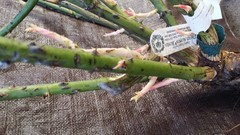
4) Put in shade until leafed out (1-2 weeks), then acclimate to sun5) Water when needed, mist as often as possible, no fertilizer until after first flush
I used to put bone meal in but I'm giving that away. When I do fertilize (because nutrients will get depleted in my pots), it will primarily be through foliar or soil drench.strawchicago z5
8 years agolast modified: 8 years agoHi Msgirl: I checked all the pics. you posted, yes, it's Dr.Huey rootstock. If you google the name of nursery you bought from, and "rootstock", it will show the info. I googled "Wayside garden and rootstock" and it showed that they use Dr. Huey. Those white shoots are from the true-rose, I WOULD NOT CHOP OFF. The fat knob is where Dr. Huey is joined with the "true-rose".
Since the root is thick and woody, it can handle chunks of red-lava-rock mixed in. I suggested layering before since I thought in terms of wimpy own-roots-band that can't handle big chunks of rocks. When I dug up Le Nia Rias since it didn't bloom for 2 years .. the root was woody and big, so I went ahead and mixed in crack corn (pH 4), gypsum, and red-lava-rock (pH over 8) in the planting hole. That rose was really perky after re-plant, and bloomed tons in spring.
Phosphorus mobility is a 1, stay put. I agree with the bottom of bark chips mixed with 10-10-10 slow-released granules, but NOT lime. Lime will prevent those granules from being utilized, those slow-released granules need acids to be dissolved. Dr. Huey is big and will give off acids, so I would mix red-lava-rock plus coco-coir well with the soil. Coco-coir can retain water like cracked corn, except it's near neutral pH. WET Coco-coir in contact with red-lava will help to release nutrients from red-lava. Dry red-lava is useless, only when it's soaking wet that it releases nutrients.
Too much red-lava rock mixed in won't hurt, since it's slow-released. But too much lime can make potassium and phosphorus NOT available for blooming, due to high pH. Dolomitic lime is better than lime, since dolomitic lime has BOTH magnesium and calcium.. I would test the soil mixture WITHOUT lime, to see how acidic. You can always water it later with dolomitic lime, or soluble lime, if the pH needs to be adjusted. Lime is best provided as needed, it's really hard to undo the lime part, since it's instant-release. So I would NOT mix in the lime, unless you test your tap water pH to see how alkaline it is. Lime is best used when you get tons of rain (at pH 5.6), but NOT when you use alkaline tap. The cheapest soil test procedure will test your tap-water pH as well.
Hydrogen peroxide is suggested at equal ratio to water to prevent root-rot. Perlite has zero nutrient, I won't use that unless you need more drainage. I would top with alfalfa hay, that stuff is excellent in providing fast growth & nitrogen. Trim root: I would trim the uppermost part of Dr. Huey if it's too wide to fit into the pot. The big-knob or bud-union, needs to 2 to 4 inches below soil level, then mulched (alfalfa hay) on top of that to keep it cool. That big-knob needs protection from being dried-out to maintain the health of the "true rose". Fertilizer can be used immediately if it's SOLUBLE, 1/2 dose of MiracleGro SOLUBLE weekly is OK, fish emulsion is even better. SOLUBLE fertilizer is needed immediately to promote leaf growth.
strawchicago z5
8 years agolast modified: 8 years agoI re-post the profile for red-lava rock here, pH at 8.2
Nitrate Nitrogen.................................4.0 p.p.m.
Phosphorus........................................6.0 p.p.m.
Potassium.........................................59.0 p.p.m.
Zinc.........................................................6 p.p.m.
Iron..................................................10.0+ p.p.m.
Copper...............................................5.5+ p.p.m.
Magnesium.......................................2.0+ p.p.m.
Boron.................................................10.0 p.p.m.
Sulfate.................................................7.0 p.p.m.
Organic Material...........................................5%
PH.........................................................8.2 Units
Calcium..................................1.3 Meq/100 gm*
Manganese...........................0.6 Meq/100 gm*
Sodium...................................0.1 Meq/100 gm*http://www.palmercc.com/lavarock.htm
Also the price for dolomitic lime is super-expensive. A cheap alternative is to water with Epsom salt (magnesium sulfate, neutral pH), and lime powder. Since the pH of red-lava-rock is high enough, lime won't be needed to balance the pH unless there's tons of rain .. and that can be sprinkled on top as needed, rather than mixing into the pot. I have Gruss an Teplitz, the parent of Dr. Huey. Gruss is known as prone to both mildew and black-spots. He was wimpy in spring & early summer, despite my dumping a bucket of water on top weekly. He's topped with red-lava-rock. Recently we have non-stop drizzle-of-rain for days, which made the red-lava constantly wet to release nutrients. Gruss shot up immediately, tons of buds. Gruss is 100% healthy after I topped him with gritty lime last fall.
strawchicago z5
8 years agolast modified: 8 years agoYesterday I spent the whole day at Cantigny park with my family. We visited McCormick mansion, the war museum, and Cantigny rose garden. The park's using high-phosphorus fertilizer backfired: that stunted Austin rose Tamora, and scorched the entire bed. Tamora has Rugosa-parentage (hates fertilizer). But their high-phosphorus regime worked well with landscape roses like Carefree Celebration, Julia Child, and Knock-outs. Their Drift roses also had tons of blooms. Landscape roses has many blooms, thus can handle high-phosphorus better than Austin roses, which has many petals & bigger petals. I re-post Roses Unlimited recommendation for soil mix:
Soil Mixture: per planting hole
1. 1 (one) cup of 46% superphosphate THIS DID NOT WORK !! I ALREADY TESTED IT
2. 1 (one) cup of dolomitic lime
3. 1 (one) cup of Mills' Magic Rose Mix (has Milorganite & high phosphorus)
4. 1 (one) cup of gypsum
5. 1/4 part compost (approximately 2 gallons)
6. 1/4 part peat moss (approximately 2 gallons)
7. 1/4 part good top soil (approximately 2 gallons)
8. 1/4 part red clay if available...substitute with good grade of commercial potting soil
**** From StrawChicago: If I have to translate the above to pots, it would be: 1 gallon plant or forest- based compost, and NOT cow-manure (too salty plus antiobiotics). The compost is meant for beneficial bacteria. 1/2 gallon peat moss or co-coir for moisture retention, 1/2 gallon red-lava-rock instead of clay, 2 gallons potting soil. 1/2 cup gypsum, 1/2 cup dolomitic lime, plus a few earthworms. Also few bark chips for the bottom mixed with slow-released granules like osmocote. Then top with alfalfa hay with NPK 2.5-1-2 for nitrogen & growth hormone.


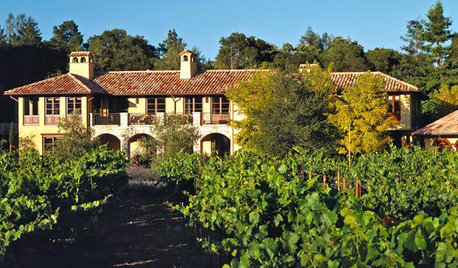














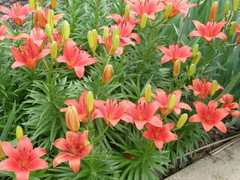

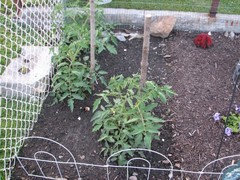
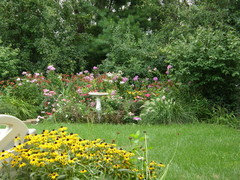

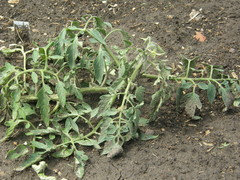

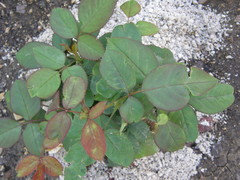

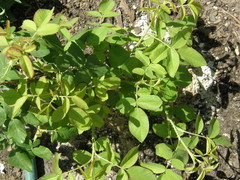

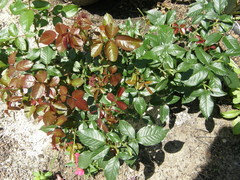

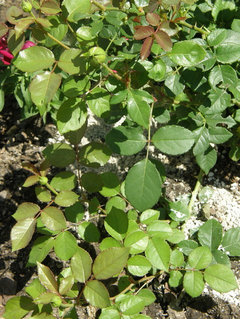
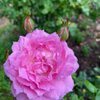


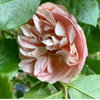
msdorkgirl